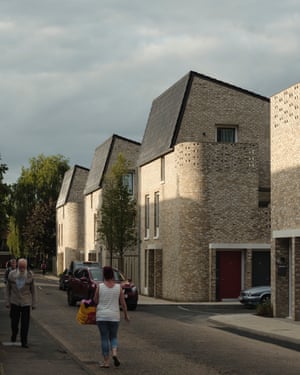[ad_1]
Rows of glossy black tiles glisten in the afternoon sun, dripping down the facades like a neatly controlled oil slick. They cap a long row of milky brick houses, whose walls curve gently around the corners at the end of the street, dissolving into perforated brick balustrades, marking the presence of hidden rooftop patios. A planted alley runs between the backs of the terraced houses, dotted with communal tables and benches, where neighbours are sitting down to an outdoor meal.
This is Goldsmith Street, a new development of around 100 homes, built by Norwich city council, without a profit-hungry developer in sight. They are not homes that fit into the murky class of “affordable”, or the multitude of “intermediate” tenures. This is proper social housing, rented from the council with secure tenancies at fixed rents. Not only that, it is some of the most energy-efficient housing ever built in the UK, meeting the exacting German Passivhaus standards – which translates into a 70% reduction in fuel bills for tenants. It might not look groundbreaking, but this little neighbourhood represents something quietly miraculous. And it almost didn’t happen.
London-based architects Mikhail Riches and Cathy Hawley first won the competition for the site in 2008. The council’s intention had been to sell the site to a local housing provider, but these plans were scuppered by the financial crisis. In 2012, the city took the brave step of deciding to develop the site itself. It was a big risk: it hadn’t built homes for decades. Ever since the Tory government of the 1980s prevented councils from reinvesting funds from the sale of their council flats into building new housing, it had lacked the resources to do so. But, like a growing number of local authorities, Norwich found a way, using a mix of borrowing, funds from its housing revenue account, some right-to-buy receipts and council reserves.

“It’s already won lots of awards, which is lovely, and other councils are really envious, but that’s not the point,” says Gail Harris, the Labour council’s deputy leader and cabinet member for social housing. “It’s about people having good quality homes and low fuel bills. And we plan to build a lot more.” In 2015, the city set up its own wholly owned housebuilding outfit, Norwich Regeneration Company, which has several other sites under way, and the council is planning to establish an additional fund to acquire sites and allow it to respond more quickly. In Goldsmith Street, the bar has been set high.
The architects won the original competition because they were one of the few firms to propose streets, rather than slabs of apartment blocks. They took inspiration from the city’s Golden Triangle, a desirable neighbourhood of Victorian terraced houses. This provided a useful lesson on density: planning rules would usually require at least 21 metres between facing homes, to prevent overlooking, but these popular historic terraces were just 14 metres apart. The architects used the precedent to argue that this new neighbourhood could be just as humanely scaled, while fitting in more homes.
The project might take its street width from the Victorians, but there is no pastiche. With generous windows, handsome brick details and bin stores cleverly hidden behind perforated bronzed screens, the homes are a smartly tailored arrival to the area of mostly postwar blocks of flats. Their rooftops are precisely angled to ensure that, even in winter, each terrace will not block sunlight from the windows of the row behind.

David Mikhail, of Mikhail Riches, was initially apprehensive when the council suggested the Passivhaus route. “Most existing examples are pretty ugly: rendered boxes with small north-facing windows.” In the architecture world, Passivhaus is a byword for clunky boxes with fat rendered walls and tiny windows, representing a kind of socks-and-sandals, ironed hair-shirt approach to design. But Goldsmith Street shows that it doesn’t have to be so grim.
“It’s onerous in a good way,” Mikhail admits, explaining how the homes had to undergo three airtightness tests during and after construction. “One pinprick in a membrane can destroy the whole thing. At one point, the builders had to go around with thermal imaging camera to find one small tear. There’s no cutting corners.” It means that heating bills should be just £150 a year, a boon when fuel poverty is a major issue.

There are additional chance benefits, too. Passivhaus means windows have to be raised up around half a metre from the ground, which happens to be a good height for a little window seat. Other clever interior touches include an intelligent use of the space beneath the canted rooftops, where day-lit first-floor landings provide a space for a study nook, home office or play area, while the upstairs flats have been cleverly designed with interlocking stairs so that each has a door on to the street.
It seems the only thing stopping Norwich, and other energetic councils, from doing more is central government rules. “There is a lot of rhetoric about needing more homes, but they should do more to help us,” says Harris. “They’ve lifted the borrowing cap, but we’re still losing a huge number of homes through right to buy.’
The city has lost around 500 council homes over the last three years through the damaging policy, which has seen a wholesale transfer of public assets into private pockets, with many of the homes now rented out on the private market. “We’re only allowed to spend 30% of the right to buy receipts on building new housing,” she adds, “and we only have three years to spend it – or else it goes to the government, with interest. How can that be right?”
[ad_2]
READ SOURCE


